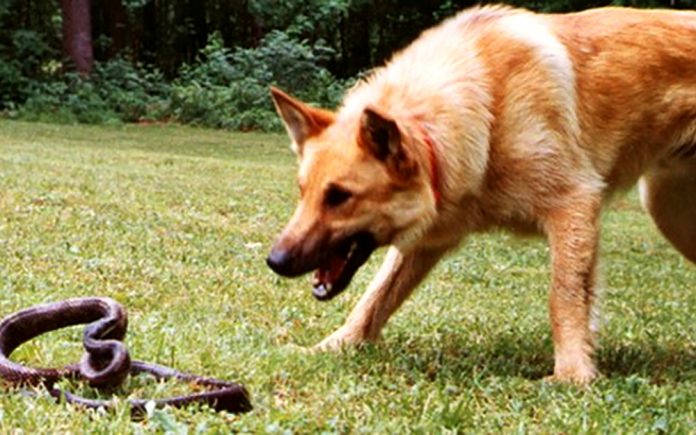
By Janet McAfee
Spring is here and many local dog owners are enjoying the great outdoors in the company of their dogs. Dog friendly hiking trails are a joyful place for you and your pooch to get some exercise and fresh air. We all love this Southern California sunshine however rattlesnakes also enjoy this sunny weather and may pose a threat to both humans and our beloved dogs. If you enjoy hiking or camping with your dog, consider learning how to protect him from venomous snake bites.
This year has seen more snake sightings than usual. Our early summer weather may be a contributing factor explaining why snakes are seen inside gated communities and residential neighborhoods. One friend discovered a snake inside his living room while his two dogs chased it underneath the couch!
Dogs have no fear of snakes, and they are naturally curious about other living creatures. They love to play in areas with thick vegetation where snakes may hide. When out walking, it is advisable to stay on the open trails. Dogs are most often bitten by snakes when walking over rough, rocky terrain or through wild vegetation. Try to prevent your dog from overturning large rocks since rattlesnakes can hide underneath these.
There are over 700 specious of venomous snakes worldwide, and almost every part of the globe is host to some of these feared creatures. It is estimated that over 150,000 dogs are bitten by snakes every year. Venomous snake bites have the potential to kill a dog. Even if your dog survives, a bite can cause serious muscle and neurological damage. The best way to enjoy the great outdoors without worrying is to have a dog that is trained to detect and avoid snakes. The Coachella Valley is a geographical area with a high concentration of rattlesnakes.
What should you do if you encounter a rattlesnake when you are outside with your dog? Freeze your movement as soon as you see or hear the snake. Ascertain its location and slowly back away until you are no longer in its striking distance. Never try to handle a snake. Never allow your dog to handle a dead snake as they can still envenomate their venom.
How do you know if your dog is bitten by a snake and what should you do? There is a puncture wound that often bleeds, and the dog is immediate and severe pain. There is usually swelling. Bruising and discoloration will occur within hours of the bite as the venom causes the blood not to clot. You may also see collapse, vomiting, muscle tremors and depression in breathing. You must seek immediate veterinary care when your dog gets a snake bite as this injury can be fatal if untreated.
 Not all veterinary clinics have the needed antivenom. Call ahead to make sure your vet has the antivenom on hand, as time is of the essence. Try to keep your pup as immobile as possible. Do NOT attempt to suck out the venom, do NOT attempt to cut open the area, and do NOT apply ice. Get a look at the snake that bit your dog so you can describe it to your vet.
Not all veterinary clinics have the needed antivenom. Call ahead to make sure your vet has the antivenom on hand, as time is of the essence. Try to keep your pup as immobile as possible. Do NOT attempt to suck out the venom, do NOT attempt to cut open the area, and do NOT apply ice. Get a look at the snake that bit your dog so you can describe it to your vet.
If you live in a “high risk” geographical area or your dog is involved in frequent camping and hiking excursions you may want to consider getting a rattlesnake vaccination for him. This relatively new vaccine was finally approved for nationwide distribution in 2004. It will help lesson your dog’s reaction to the bite, but you will still need to seek immediate veterinary care.
Stay safe while enjoying the outdoors with Fido. Be vigilant and keep an eye out for these abundant reptiles.











































